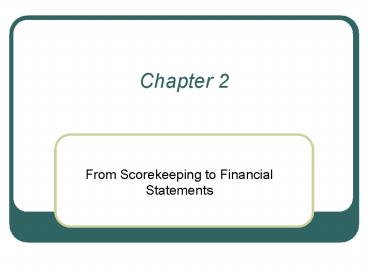From Scorekeeping to Financial Statements - PowerPoint PPT Presentation
1 / 20
Title:
From Scorekeeping to Financial Statements
Description:
Passwords can be obtained in BX 204C, if you forgot yours or need one. ... In-class Work. T/F and multiple choice questions from Ch. 2. Homework ... – PowerPoint PPT presentation
Number of Views:50
Avg rating:3.0/5.0
Title: From Scorekeeping to Financial Statements
1
Chapter 2
- From Scorekeeping to Financial Statements
2
Learning Objectives for Chapter 2
- See syllabus
3
Financial Accounting Statements
- Balance Sheet - reports the assets, liabilities,
and stockholders equity at a specific date - Income Statement - reports the results of
operations for a specific period of time - Retained Earnings Statement - reports the changes
in retained earnings for a specific period of
time - Statement of Cash Flows - reports the cash
receipts and payments for a specific period of
time
4
Brief Introduction to the Balance Sheet and
Income Statement
- Balance sheet snapshot of a companys financial
position at a certain point in time. - Income statement summarizes financial activity
of a company for a certain period of time. - Relationship between the balance sheet and income
statement
5
Basic Terms
- Assets - resources owned by a business
- Liabilities - debts and obligations of the
business - represents claims of creditors on the
assets of the business - Common stock - stock representing the primary
ownership interest in a corporation
6
Practice With the Balance Sheet and Income
Statement
- Wiggler Company
7
Tuesday, June 21
- Email use your COB account. To find your
account - Go to the computer lab in the basement
- Log in under your ONID account and open Outlook
- Open a screen to send a new email, type your last
name in the address space, then key Ctrl k - A list of email addresses will appear, find your
COB address - Access to course materials folder
- Go to the computer lab in the basement and log in
under your COB username and password. Passwords
can be obtained in BX 204C, if you forgot yours
or need one. - Now, the URL \\cob-storage\classes\BA215wong can
be used in the Explorer web browser
8
Debit and Credit Conventions and T-accounts
- T-accounts are a convenient way to record
transaction information and keep running totals
of accounts. - Debits represent the left hand side of a
T-account. - Credits represent the right hand side of a
T-account. - See Fig 2.2 of text
- Balance Sheet Accts. Income Stmt. Accts.
- ? Assets Liabilities ? ?
Expenses Revenues ? - Equity ?
9
Recording Transactions
- Note for every transaction
- debits credits
- For every transaction involving only balance
sheet accounts A L E - Balance sheet for Wiggler, up to transaction 5,
using T-accounts for assistance.
10
The Trial Balance
- A listing of all debit and credit balances as of
the balance sheet date - Used to insure that debits credits for recorded
transactions - Checks whether the accounting equation was
maintained - No assurance that transactions have been recorded
properly
11
Trial Balance for Wiggler transactions 1 to 5
- Put together a trial balance for these
transactions. - Debit Credit
- Cash 3,250
- Inventory (worms) 220
- Land Farm 750
- Accounts Payable 120
- Note Payable 2,100
- Common Stock 2,000
- Total 4,220 4,220
12
Balance Sheet Classification and Some Common
Accounts
- The balance sheet classifies assets and
liabilities according to whether they are short-
or long-term. - Generally
- Short-term assets are those which will be
consumed or converted to cash in a year or less.
All other assets are long-term. - Short-term liabilities are those which will be
paid in a year or less. All other liabilities
are long-term. - Common balance sheet accounts see sample
balance sheet, and text pp. 54-58.
13
Income Statement
- Classified income statement
- Definition of elements
- Revenues resource inflows earned from the sale
of products or services that are the main
activities of the organization - Expenses - resource outflows incurred in the sale
of products or services that are the main
activities of the organization - Gains similar to revenues, only from ancillary
activities of the organization - Losses similar to expenses, only from ancillary
activities of the organization
14
Table 2.3 From the Text Sample Income Statement
Operating Section
- Net sales 2,500,000
- Cost of goods sold 1,900,000
- Gross margin 600,000
- (Discussion of these three accounts on pp. 50-51)
15
Table 2.3 From the Text Sample Income Statement
Operating Section
- Operating Expenses
- Selling expenses
- Sales salaries 140,000
- Advertising expenses 20,000 160,000
- Administrative expenses
- Office salaries 170,000
- Rent 20,000
- Depreciation 40,000 230,000
- Total operating expenses 210,000
- (Discussion of these accounts on p. 51)
16
Table 2.3 From the Text Sample Income Statement
Non-Operating Section to end
- Other income 20,000
- Other expenses (interest) 35,000 55,000
- Income before taxes 195,000
- Income taxes 97,500
- Net Income (Income after taxes) 97,500
- This is the section where gains and losses
would also appear - (Discussion of these accounts on pp. 50-51)
17
Statement of Retained Earnings
- Helps to link the balance sheet with the income
statement. - Closes the results of the income statement (net
income) to Retained Earnings - Accounts for dividends paid from Retained
Earnings. - Overview of the statement
- Beginning Retained Earnings
- Net income (Net loss)
- - Dividends paid or declared and payable
- Ending Retained Earnings
18
In-class Work
- T/F and multiple choice questions from Ch. 2
19
Homework
- Finish recording the transactions in the Wiggler
exercise - After recording the transactions
- Make a trial balance, balance sheet, and income
statement for Wiggler
20
(No Transcript)































